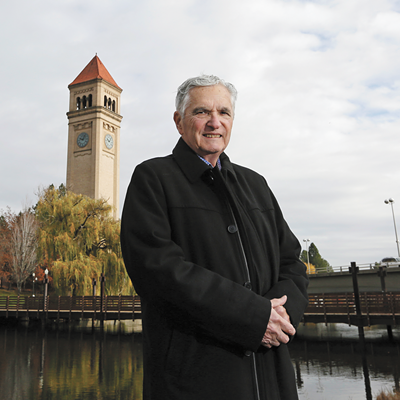The 100th walk started at the end of the North Adams streetcar line. It was the first truly warm Sunday in April, and the women wore brimmed hats against the spring sun. From the northwest edge of the city, the group walked up past Nine Mile Falls and the historic Spokane House, then east along the winding Little Spokane River with a stop for a picnic lunch, then across the river at the Glen Tana Dairy. The bus from Whitworth College returned the walkers to the North Howard streetcar. Twelve miles — it was actually a fairly short excursion for the Spokane Walking Club.
Eventually the club would grow in size and ambition to become the Spokane Mountaineers, a regional leader in conservation and recreation. But in 1915 — three years before that 100th walk, and 100 years ago this September — it started with a group of five librarians led by one especially adventurous and unlikely founder: Ora Maxwell.
Maxwell was known in Spokane for her steady presence behind the circulation desk at the Spokane Public Library, then housed in the neoclassical building where Riverside and First converge at the west end of downtown. Maxwell worked at the library from 1911 until her death, when she was remembered as "the adviser in reading" to thousands of people in Spokane. She had attended school in Wisconsin and Montreal, and was known to dress fashionably. The poet Vachel Lindsay was a close friend during the years he lived in Spokane, and in a book inscription he wrote to her: "You're a very charming/And very distinguished/Citizen of the Universe."
Maxwell spent most of her adult life in Spokane, living in her sister's home on West Seventh Avenue, but she had a fearless zeal for getting out into the world. She spent time living in Los Angeles and New Orleans in the early part of the century, and traveled around Europe in her 50s with a female friend.
She was already in her mid-40s when she and four library colleagues decided to form a walking club, with the goal of exercising in the outdoors and exploring the landscape around Spokane. The walks were often 12 to 15 miles, and sometimes as many as 20 or 25. In a newspaper interview, Mabel C. Hutchins, among the original members, explained her motivation: "Exercise in the open air is the thing most essential to me."
There were no state parks around Spokane at the time — no developed parks for hiking, no trails maintained by the public. Automobiles were already beginning to crowd Spokane's downtown streets when the walking club formed in 1915, ultimately transforming Americans' relationship with the outdoors by making remote areas easily accessible.
For Maxwell, one insurmountable challenge remained: her health. She had asthma all her life; while not rare, it was poorly understood at the time. As the walking club became more ambitious, it's not clear how long its first president remained an active participant. Maxwell went on that 100th walk past Nine Mile Falls, but she was not part of the group who were caught in heavy rain and fog while climbing Mount Spokane late in 1916, or among the nine who packed pedometers and ham sandwiches for a weeklong trip to Glacier Park in 1917, in which they covered 105 miles.
Maxwell died in 1932 following an operation at Sacred Heart and years of poor health, according to her obituary. By then, the club she started had well over 50 members, and some were summiting peaks like Mount Rainier and Mount Adams. At her funeral, the pastor read "Trees" by Joyce Kilmer, a favorite of Maxwell's: "I think that I shall never see/A poem lovely as a tree..."
Today, the spirit of Maxwell's walking club continues with groups who gather to hike and backpack around the region. The Spokane Mountaineers now encompasses a wide range of activities, from Wednesday after-work hikes — not so different from those of the Spokane Walking Club — to mountain-climbing and avalanche clinics. "We have a wide range of abilities," says Holly Weiler, one of the Hiking Committee leaders. "There's usually a trip for everyone." ♦
Thanks to the following for research on Ora Maxwell's life: Chic Burge, Jim Kershner, Mary E. Petty, Shaun O'L. Higgins and the Northwest Room at the Spokane Public Library.
Steppin' Out
If the Spokane Walking Club's 15- and 20-mile hikes seem ambitious even with the modern conveniences of comfortable shoes and clearly marked trails, there's no need to worry. Making time for a walk — even a short one — can provide important health benefits.
The Centers for Disease Control and Prevention recommends 150 minutes of moderate-intensity aerobic activity a week for adults, along with muscle-strengthening activities. Brisk walking is a great way to meet that aerobic goal. And the best news is that short excursions add up — the CDC says 10 minutes at a time is fine.
"You will still reap the health benefits from that 10 minutes," says Heleen Dewey of the Spokane Regional Health District's Healthy Communities program, noting the SRHD offers walking maps with recommended routes in Spokane County, which include distance, estimated calories burned and difficulty rating, among other information. Find maps and other resources at srhd.org/topics/walkingmaps.
Herbs to Inhalers
At the time Ora Maxwell lived in Spokane a century ago, the incidence of asthma was on the rise. Finding effective treatment for the disease had proven elusive for thousands of years. Ancient Chinese and Egyptian remedies incorporated the burning of various herbs, while other historic approaches were more symbolic, such as eating the lungs of a fox. Acupuncture, massage and bloodletting were variously suggested to help improve the balance of "humours." As industrialization took hold in the 19th century, the focus shifted toward identifying and avoiding triggers of asthma attacks. Advice from doctors could be contradictory: Get more fresh air. Avoid being outdoors.
Odd as it now seems, in Maxwell's time, remedies commonly involved smoking. An 1895 advertisement in the Spokesman-Review challenged all asthma sufferers to come try a free trial box of Dr. Schiffman's Asthma Cure, a smokable powder made with two plants from the nightshade family. In the early 20th century, "asthmatic cigarettes" incorporating the potentially deadly nightshade belladonna (the source of the drug atropine), were touted to sedate agitated airways.
The most significant breakthrough came in 1955 with the introduction of the first modern inhaler, invented by a doctor whose daughter had asthma. Early inhalers contained epinephrine, which is still used today in severe asthma attacks; modern inhalers contain a bronchodilator, such as albuterol or more recently, a drug called ipratropium, which in a case of history repeating itself, is synthesized from atropine.



















